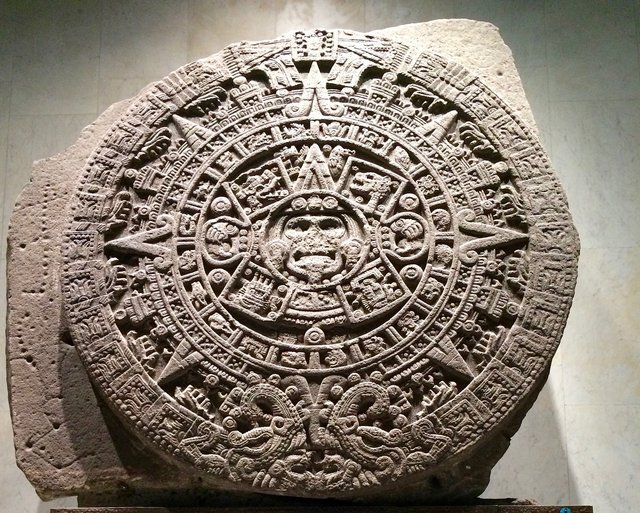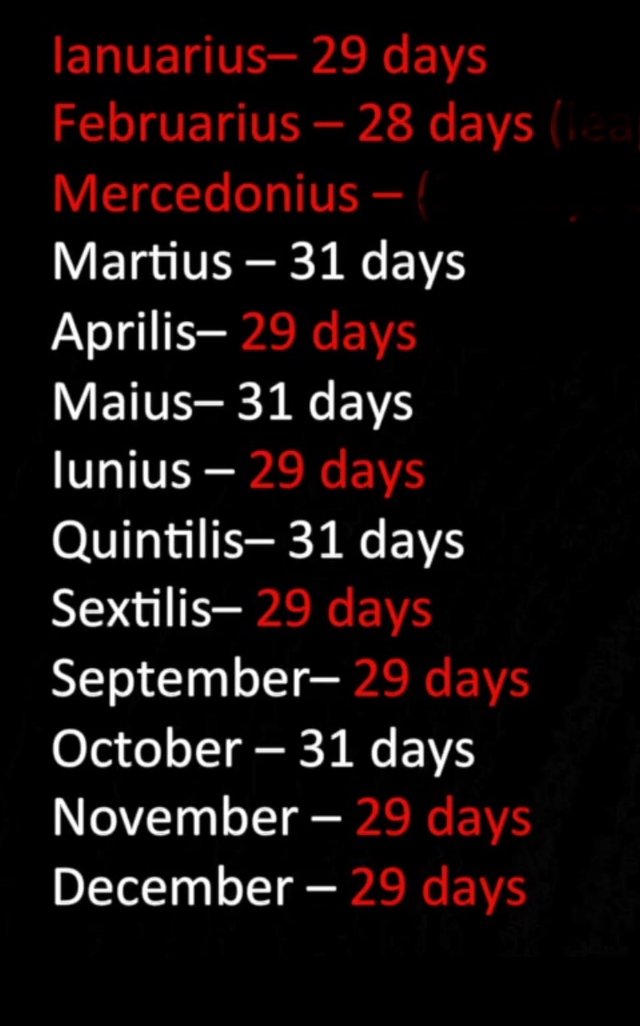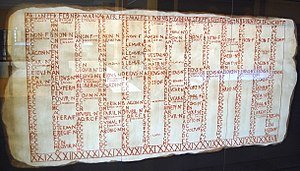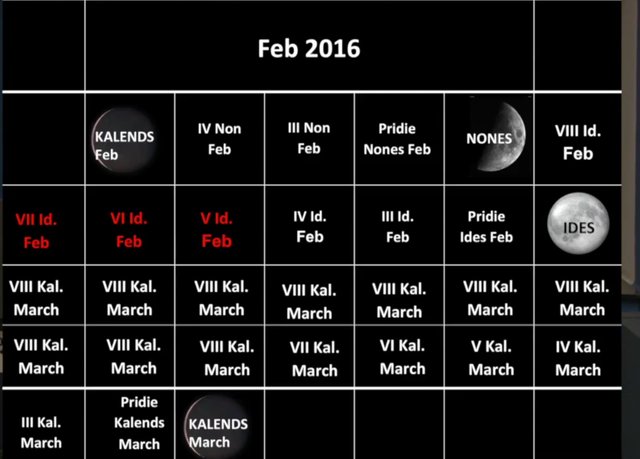TIMEKEEPING: A BRIEF HISTORY OF CALENDARS.
WHY DO WE HAVE CALENDERS?
The relentless cycles in nature such as sunsets and sunrise, changes in the seasons, the moon cycles and the tides would have been just as obvious and fascinating to the ancient man as it it remains today. These cycles have great impacts on human life and a reckoning of these rhythms was needed. Organizing time into simple to access units for purposes of record keeping and arranging human and societal activities such as those associated with agriculture is the basic reason for time reckoning and hence the invention of calenders.
The waxing and waning of the moon was perhaps the simplest way of timekeeping for the primitives. The earliest known calenders were based on lunar cycles.
LUNAR CALENDER.

source
The most recognizable astronomical event for the early man, on a day to day basis, would have been Lunation. The earliest known calenders are lunar based. A lunar cycle is approximately 29.5 days. This lends itself to a problem with the seasons. A lunar year is about 11 days short of a Solar year as 29.530585 x 12 is 354 days approximately . Thus the seasons keep sliding across a lunar calender from year to year. Lunar calender is still used to day in Muslim and Jewish traditions. For Muslims the fasting month of Ramadan falls in different seasons across the span of time.
The Babylonian calendar and the early Egyptian calendar are believed to be Lunar cycle based calenders. Lunar calendars were also used by the Chinese and the Greeks.
SOLAR CALENDRAS.
It was the Egyptians that used Sirius to count the days in a Solar year. They adjusted the lunar month to 30 days each giving a total of 360 days and then to account for the 5 leftover days, they had 5 days of festivities. Quite sensible, isn’t it? Below is an image of Aztec calender . The Xiuhpohualli part of this calendar is a 365 day cycle and considered to be a solar based calendar system.

source
There are many ways to make a calendar based on astronomical observations and seasons. There are over 40 calendar systems in use today. A mention of these is omitted for brevity. The post will focus on the evolution of the Roman calendar used worldwide today.
ROMAN CALENDAR.
Romulus: First king of Rome.
Romulus, the legendary first Roman leader, introduced the Roman calendar in the early 700s BCE. He attempt at the calendar was to bring together the lunar and the solar calendar systems. He seems to have liked the number 10. He divided his senate into tens and his military into tens. The also counted using digits. Thus it came naturally to early Romans to divide the year into 10 months. The year begins in March ( Maius ). Spring is when the earth seems to come alive and it must have seemed logical to start the year in concert with the yearly re birth of the earth.
 [source,self]
[source,self]The first 4 months are based on gods and goddesses and the remaining months are simply words for the number of the month. This explains why our 10th month is called October as January and February were later added as we will discuss later.
The 61 left over days posed a problem. These days are called intercalarary days. Although not exactly but with some approximation these winter days represent the difference between the lunar cycle months and the solar year. Superstitiously these days were considered unlucky days and were never named.
Numa: Second king of Rome.
He considered odd numbers to be lucky. So he changed all 30 day months to 29 days. He created 2 new months.
January ( Janus, god of beginnings and endings) = 29 days.
February ( februare, to purify: Februa was a purification festival of Sabine held in February ) = 28 days.
But odd numbers were considered unlucky! What gives? Numa was trying to line up the calendar with the yearly 12 lunar cycles. He needed to complete a 355 day calendar. February was chosen to be the unlucky month.
So now we have advanced to a 12 month calendar from a 10 month calendar.
This still left a few intercalaray days. Just as we have a leap year, Numa had a system of packaging the left over days every few years into a leap month to keep the lunar months synchronized with the solar cycle. This month when added was added as the third month, after February and before March (Martius). It was called Mercedonius.

[source,self]
Mercedonius was the month when wages were given out. Priests decided when to add Mercedonius and when to omit it from the calendar. Decisions were political and thus never favored the general population. More on this later. For now let’s take a look at a picture of a Roman calendar. The picture lacks any clarity likely due to the age of the calendar.

[source,google images]
The following image is a modern day representation of how the above calendar would have been written out and how it was meant to be read. This image is taken from an NPL lecture given by Dr. Carroll. All credits to her for the image. It is an example what a February 2016 calendar would look like from a Roman calendar perspective.

[ source, as mentioned]
Kalends was always the day of the new moon. It was the first day of the month. This is where the word calendar comes from.
Nones signified the day when the moon reached the quarter phase. It also means nine. Counting backwards from Ides, it is the ninth day.
Ides means “to divide”. This is the day of the full moon. Full moon comes halfway between each lunation.
The day before the 3 major named days is called Pridie of the respective day. All other days are simple numbered counting backwards from the named days. You read it right. Romans counted backwards when naming the calendar days. I hope this makes the calendar a bit clearer.
All the intercalary days and the manipulation of Mercedonius led to the calendar slowly falling out of sync with observed seasons. Imagine March signifying spring but falling into winter time.
Julius Cesar and his reforms.
By the time he got to the throne the calendar was way off. Julius reformed the calendar leading to what we call now the Julian calendar. His major reforms included adding many extra days into 1 year. That was 46 BCE. That year was 445 days long. After that he changed a calendar year to 365 days and added 1 extra day every 4 years ( leap year ). He got rid of Mercedonius. Spring time now once again occurred in March. He changed some of the number of days of the months. In honor of these reforms, the senate renamed Qunitilis to Julius. That is where we get July. After the death of Julius, the priests changed the leap year to every 3 years from every 4 years. Things went haywire and out of alignment once again after some time.
Augustus reforms it back.
Augustus corrected the mistake made by the priests. Unlike Julius, he reformed the calendar over a period of 16 years rather than one, by adding/ removing the days slowly and leap year was again every 4 years. The month of Sextilis was renamed Augustus. Hence we now have the month of August. As July (Julius ) had 31 days, Augustus was not not going to settle for anything less. So August has 31 days.
Constantine leaves his mark.
He introduced the concept of a 7 day week. He denoted Sunday as the Holy day. Note that he was the first Christian Emperor so his work makes sense. It is interesting to note that he convened the council of Nicea which was responsible for the early formula of timing of Easter.
The calendar at this time with 365 days in a year and every 4th year was a leap year. This was 11 minutes too long, per year. Although remarkable accuracy had been achieved, the 11 minute difference would become monumental over hundreds of years.
Pope Gregory Xlll.
The Pope removed 10 days from the calendar to put everything back in alignment. He introduced a new leap year system. The leap year is still every 4 years except that we skip the centuries. The exception is that we include the centuries if divisible by 400. For example you would include 1600 but skip 1700.
This is the system we still use today.called the GREGORIAN CALENDAR.
Important notice about this post.
This post was comprehensively researched. There are historians/ non historians, who have disputed what is generally agreed upon by most historians. For example, I came across texts/comments that suggested that existence of Romulus and Numa was in doubt. Such matters of dispute are commonplace in history. I have attempted to leave controversies out such as the timing of Easter and many other topics. Comments are welcome but keep in mind that unnecessary arguments are not. Hope you enjoy the post and perhaps find it informative.
REFERENCES.
- http://historyworld.net/wrldhis/PlainTextHistoriesResponsive.asp?ParagraphID=bvt
- https://eclipse.gsfc.nasa.gov/SEhelp/calendars.html#Intro
- http://www.webexhibits.org/calendars/calendar-roman.html
- https://www.childrensmuseum.org/blog/why-feb-28-days
- https://www.tiffany-parks.com/blog/2011/11/10/numa-pompilius-and-his-calendar
- https://www.timeanddate.com/calendar/gregorian-calendar.html
- http://www.legendsandchronicles.com/ancient-civilizations/the-ancient-aztecs/aztec-calender/
Congratulations! This post has been upvoted from the communal account, @minnowsupport, by nedspeaks from the Minnow Support Project. It's a witness project run by aggroed, ausbitbank, teamsteem, theprophet0, someguy123, neoxian, followbtcnews, and netuoso. The goal is to help Steemit grow by supporting Minnows. Please find us at the Peace, Abundance, and Liberty Network (PALnet) Discord Channel. It's a completely public and open space to all members of the Steemit community who voluntarily choose to be there.
If you would like to delegate to the Minnow Support Project you can do so by clicking on the following links: 50SP, 100SP, 250SP, 500SP, 1000SP, 5000SP.
Be sure to leave at least 50SP undelegated on your account.
That's an excellent summary of how the modern calendar came about. Supposedly when Pope Gregory Xlll cut the 11 days from September, 1752, there were a lot of very unhappy people (even reports of riots) for various reasons that ranged from accusations it was part of Catholic plot, to landlords shortchanging tenants all the way to people thinking their lives were being shortened!
Thankyou for reading this Terry. You are absolutely right. Pope removed 10 days in the 1500s. When Britain finally adopted it in the 1700s, much time had passed and they had to deduct one more day making it 11. And yes as you said, some parts did not adopt it simultaneously. It was chaos.